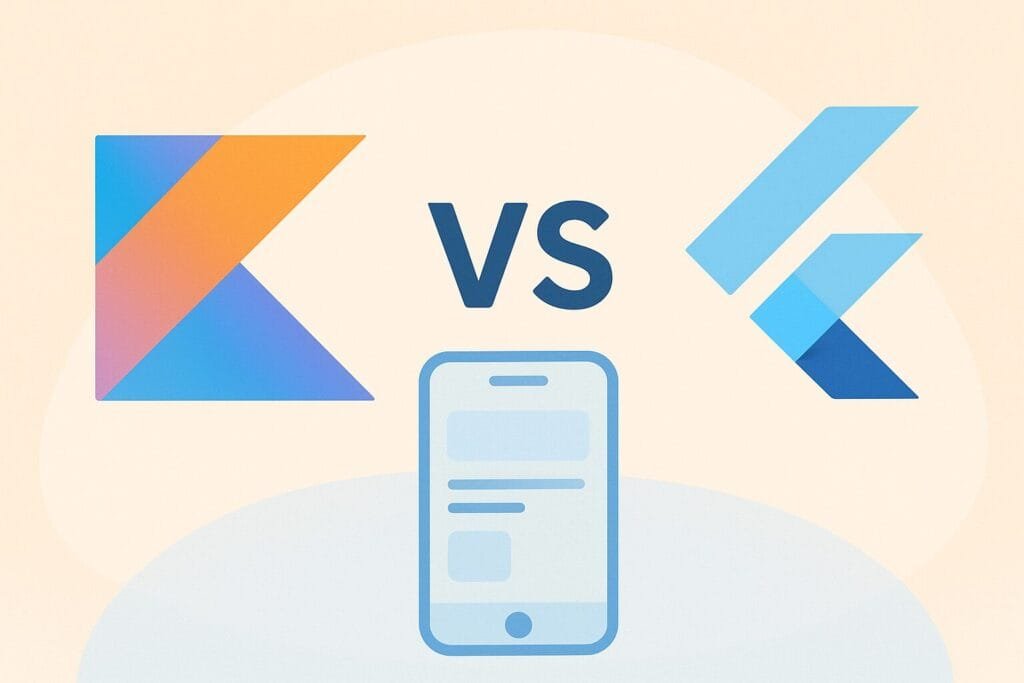As cross-platform app development continues to dominate the mobile industry, two major technologies are at the center of discussion — Kotlin Multiplatform and Flutter. Both are modern, open-source solutions designed to reduce development time, cost, and effort by sharing code across Android and iOS. But which one truly represents the future of mobile app development?
In this article, we’ll explore the differences, strengths, and weaknesses of Kotlin Multiplatform and Flutter. You’ll also find a detailed comparison table and insights to help developers, startups, and businesses choose the right framework for their next mobile project.

1. What Is Kotlin Multiplatform?
Kotlin Multiplatform (KMP) is an initiative by JetBrains — the same company behind the Kotlin language — to allow developers to share code between platforms while keeping native UI and experience intact. With Kotlin Multiplatform, you can write the business logic, networking, and data layer once, then use platform-specific code for Android, iOS, and even desktop or web targets.
Unlike other cross-platform solutions, Kotlin Multiplatform does not force you to abandon native development tools. Instead, it integrates smoothly with existing projects and allows gradual adoption.
2. What Is Flutter?
Flutter, developed by Google, is a UI toolkit that enables developers to build beautiful, natively compiled applications for mobile, web, and desktop from a single codebase. It uses the Dart programming language and provides a reactive, widget-based framework for fast and expressive UIs.
Flutter renders everything using its own rendering engine, Skia, which allows it to deliver a consistent look and feel across platforms while maintaining high performance.
3. Key Comparison: Kotlin Multiplatform vs Flutter
Below is a side-by-side comparison of Kotlin Multiplatform and Flutter based on important factors like performance, ecosystem, UI flexibility, and developer productivity.
| Feature | Kotlin Multiplatform | Flutter |
|---|---|---|
| Language | Kotlin | Dart |
| UI Framework | Uses native UI components | Uses Flutter’s own widgets |
| Performance | Near-native (depends on implementation) | High, thanks to Skia rendering engine |
| Code Sharing | Business logic and backend layer | UI + Logic from single codebase |
| Learning Curve | Easy for Android developers | Moderate; requires learning Dart |
| Community & Ecosystem | Growing, but smaller than Flutter | Large and active community |
| Tooling | Supported in Android Studio & IntelliJ IDEA | Excellent tools with Flutter SDK |
| Hot Reload | Limited (depends on setup) | Available and widely used |
| Platform Targets | Android, iOS, Web, Desktop | Android, iOS, Web, Desktop |
| Integration with Native Code | Seamless; works directly with native APIs | Uses platform channels |
| Best For | Projects with existing native codebases | New projects needing a unified UI |
4. Performance Comparison
Performance is one of the main factors when choosing a cross-platform solution. Flutter offers nearly native performance since its engine compiles directly into native ARM code and manages its own rendering pipeline. On the other hand, Kotlin Multiplatform doesn’t aim to replace the native UI — it shares only business logic — meaning the final performance depends on native views, which are already optimized.
In short, both deliver excellent performance, but Flutter’s full control over UI rendering gives it an edge in some use cases, especially for games or animation-heavy apps.
5. UI Development Experience
Flutter’s widget-based UI system is one of its strongest advantages. Developers can build custom designs quickly using pre-built widgets and Material or Cupertino components. However, this also means that the look may not always perfectly match native apps.
Kotlin Multiplatform, in contrast, allows developers to use native UI frameworks (Jetpack Compose for Android and SwiftUI for iOS), resulting in apps that feel completely native on each platform.
6. Ecosystem and Community
Flutter currently has a larger ecosystem with extensive documentation, open-source plugins, and community-driven libraries. Kotlin Multiplatform is newer and still growing, but the backing from JetBrains and integration with Kotlin gives it strong potential for enterprise adoption.
For beginners and teams looking for ready-made solutions, Flutter might be easier to start with. However, Kotlin Multiplatform offers more flexibility for teams who already have native experience or large existing codebases.
7. When to Use Kotlin Multiplatform
- If your project already uses native Android and iOS codebases.
- If you need full control of the UI using native frameworks.
- If you prioritize shared business logic over UI uniformity.
- If your team is proficient in Kotlin or Java.
8. When to Use Flutter
- If you want to build apps from a single codebase quickly.
- If you need a consistent look across platforms.
- If your team prefers Google’s development ecosystem.
- If you want a strong community and ready-made libraries.
9. Future Outlook
The future of mobile development will likely involve both technologies. Flutter will continue to be popular for startups and fast UI delivery, while Kotlin Multiplatform will grow within enterprises that value native performance and modular architecture.
Interestingly, Kotlin Multiplatform Mobile is evolving rapidly and could soon rival Flutter in terms of adoption once it reaches a more stable release stage.
10. Conclusion
There’s no one-size-fits-all answer to whether Kotlin Multiplatform or Flutter is better. Your choice depends on your project goals, team skills, and long-term maintenance plan.
Choose Kotlin Multiplatform if you want to retain native UI performance and reuse existing codebases. Choose Flutter if you want rapid development and consistent UI across all devices.
Both are solid investments for the future of mobile app development, and understanding their strengths will help you build faster, more scalable, and user-friendly apps.

